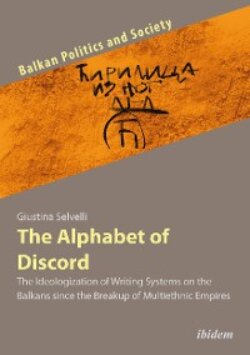Читать книгу The Alphabet of Discord - Giustina Selvelli - Страница 11
2. THE RECEPTION OF THE ABECEDAR PRIMER (1925) IN BULGARIA 2.1 Issues related to the adoption of new writing systems
ОглавлениеIn the aftermath of the First World War and of the dissolution of the Ottoman and Habsburg Empires, the Balkans still stood out as a region characterized by high levels of cultural, ethnic, linguistic and “graphic” diversity. If we consider the number of scripts present in the peninsula at that time, we find almost ten different writing systems in use: Serbian and Bulgarian Cyrillic, Greek, Latin, bosančica, Arabic characters modified to write the Turkish, Bosnian, Albanian and Greek languages, traces of the Glagolitic alphabet, Hebrew characters to write the Judeo-Spanish language and Yiddish, and Armenian characters used by the Armenian minorities (cf. Zakhos-Papazahariou 1972: 146, Parmeggiani Dri 2004: 12). This phenomenon was not to be found in any region of Western Europe but was comparable to the situation in some parts of Central and Eastern Europe and must therefore be viewed as a feature of a highly diverse post-imperial world, for whose comprehension the conceptual tools derived from the history of the Western world reveal themselves often insufficient (Barkery 1997: 100).
The composite cultural and linguistic character of the region has been considered by some as an obstacle to harmonious development and progress (May 2013: 24). The nineteenth-century liberal John Stuart Mill, for example, stated in 1861 that “[f]ree institutions are next to impossible in a country made up of different nationalities (…) especially if they read and speak different languages (...) The boundaries of governments should coincide in the main with those of nationalities” (cit. in Edwards 2009: 189). Mill’s opinion appears to have been largely undermined by a Western Eurocentric vision, based on a concept of the nation-state that has become more and more dominant since the 19th century. It could also be interpreted as the symptom of a sort of “orientophobia”1 which applies reductionist criteria to the idea of civilization and to a certain extent fulfills the interests of domination. In fact, it is much easier to exercise political or even just “conceptual” control over a part of the world when it presents itself as linguistically, ethnically and confessionally homogeneous, and not jeopardized, as in the Balkans, by “[s]cores of tongues, dialects and religions,” which determined a kind of “handicap of heterogeneity,” as one observer affirmed (Roucek cit. in Bardos 2013: 27).
Unfortunately, the influence exerted on the socio-political development of the Balkan countries by this view of heterogeneity as an unwelcome “imperial remnant,” capable of hindering the implementation of modern state structures, was immense (see, for example, Todorova 1996: 45-77). The peoples of the region, in fact, “internalized not only the geopolitical split between Western and Eastern Europe, but also the split between Europe and the Orient” (Bjelić 2011: 12). Becoming Westerners implied adopting both the values of the West and the stereotypes it nurtures of the East (ibid., 14). Predictably, this attitude produced various phenomena of “identity short-circuiting,” characterized by persistent internal negations, suppressions and conflicts.
In this respect, it is interesting to note the influence of these Western-influenced concepts of identity on the development of alphabet ideologies. A paradigmatic case is that of Romania and its transition to the Latin alphabet after centuries of using the Cyrillic alphabet in the second half of the nineteenth century (cf. Lörinzci 1982). This was indeed a deliberate act of “rapprochement” with the European and Western world, probably also dictated by the hope of gaining important cultural advantages, and a more favorable recognition on the part of the “Significant Others”2 of the West.
In this context, consideration of the proposals to adopt alternative writing systems is an essential part of the analysis of alphabet ideologies. With regard to the languages of Southeast Europe, between the end of the 19th and the beginning of the 20th century, the adoption of new writing systems played a major role in the history and development of many states in the region, such as Romania (in the 1860s), Albania (1909) and Turkey (1928). The affirmation of a certain relationship of independence between writing and language (Wellish 1978: 41-44) set an important and momentous precedent: a language that had appeared in a particular alphabet could begin to be written at any time using another writing system, one that definitively replaced the previous one.
Against this background, the publication in 1925 of the so-called Abecedar, a didactic text intended for the Slavic-speaking population of Aegean Macedonia, led to a lively dispute involving Bulgarians, Serbs and Greeks, as well as members of the League of Nations. At the heart of the controversy was the fact that the text had been written in Latin rather than Cyrillic characters. The dispute over the Abecedar was the first opportunity in independent Bulgaria to discuss the question of whether or not to accept an alternative writing system for the national language. In this country, the condemnation of the Latin alphabet was accompanied by a passionate defense of Cyrillic. The testimonies of authoritative Bulgarian scholars of the time, such as Ivan Shishmanov and Lyubomir Miletich, who actively participated in the debate on the Abecedar, prove that the Cyrillic alphabet was seen by Bulgarian society as an indispensable element of the national identity, playing a pre-eminent role in the collective self-representation practices of the post-war and post-imperial (Ottoman) period. The traditional writing system, which joined the delicate political debate related to the “Macedonian question,” was explicitly made part of a discourse about the country’s national and historical identity, imbued with strong symbolic cultural contents and values.
